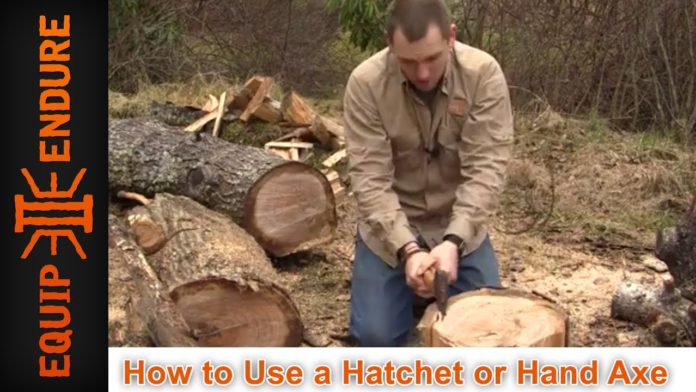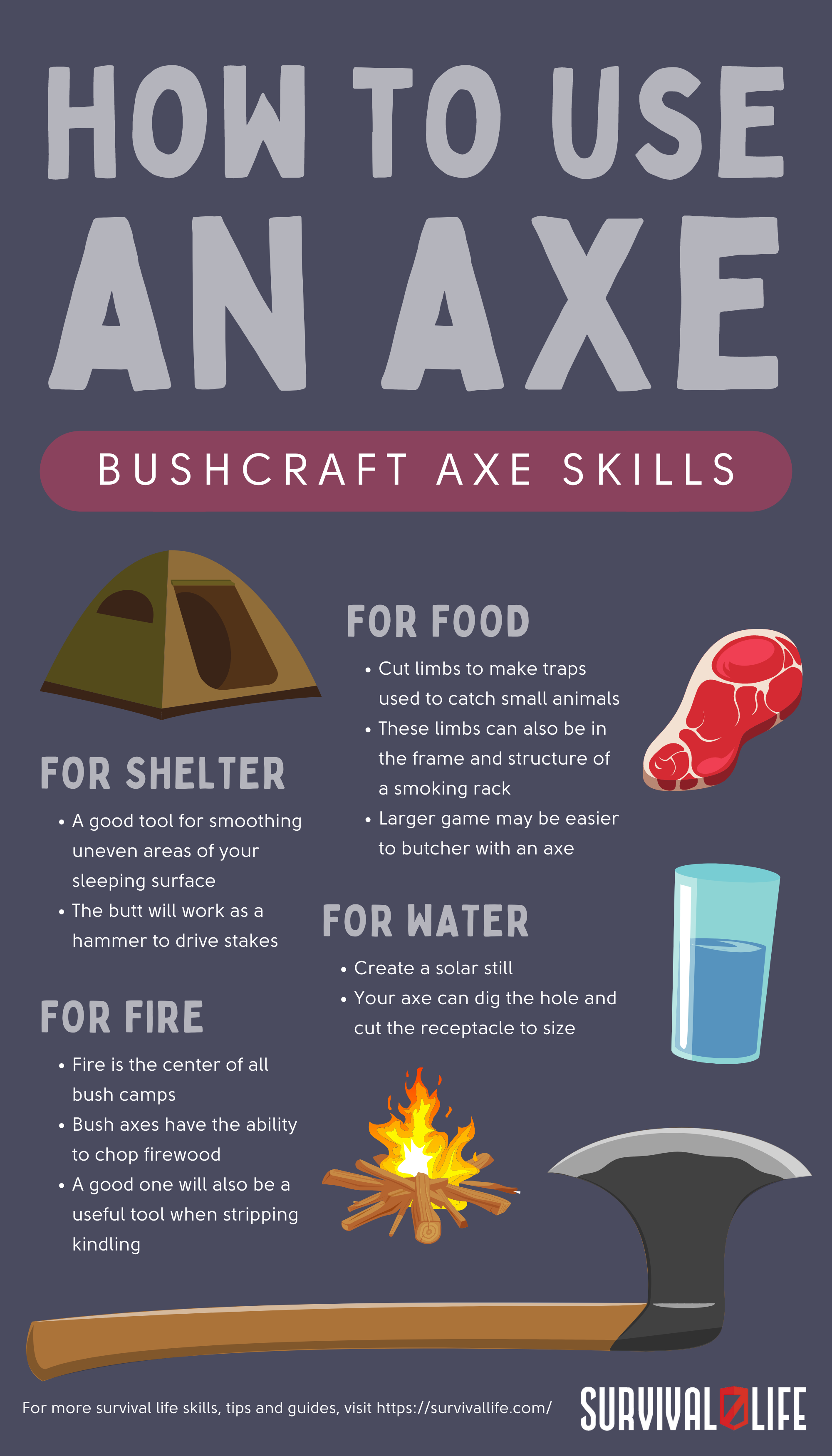There are many ways on how to use an axe. You can use one when building shelter, making fires, procuring food, and even finding water.
Read on to find out how to use an axe, its history, different kinds of axes, and more.
How To Use an Axe and Different Types of Axes
History of Axes
The hand axe was a shaft-less tool used around 1.6 million years ago. Though it has little resemblance to its modern equal, it is the earliest form of an axe.
The hand axe may also even be one of the oldest pieces of tools used by early humans.
For many thousands of years, man continued making improvements to the ax, and it evolved. The addition of handles leads to two types of axe, a shaft hole, and a non-shaft hole.
As the names sound, one had a shaft that went through the blade and the other, a shaft attached outside the blade.
The Bronze Age led to one of the most significant axe updates.
Copper and bronze became the most common material used for making axe heads. This allowed for the heads to be mass-produced through casting.
The Iron Age had a similar impact when the use of iron became more prevalent.
When forestry became a big business so did axe making. The forestry industry is also credited with the common look of most axes today.
Axe production moved out of the small forges and became a commercial enterprise.
4 Ways On How To Use an Axe
1. Shelter
Having a roof over your head is important in any environment. Even the crudest or most basic camps will need shelter.
In most locations, you will have to build your shelter completely from scratch.
From felling small trees, to cutting limbs, your axe will be a workhorse when building a shelter. It will also be a good tool for smoothing uneven areas of your sleeping surface.
In a pinch, the butt will work as a hammer to drive stakes.
2. Fire
Fire is the center of all bush camps. Whether it’s for warmth, meal preparation or water purification creating fire is crucial.
Regardless of your creation method, you will need plenty of wood.
An important feature for you to look for in your bush axe is its ability to chop firewood. A good one will also be a useful tool when stripping kindling.
Some can also get a spark with flint to start your fire.
3. Food
Even the most hardened outdoorsman needs to eat. Without food, your strength, stamina, and mental acuity will diminish.
Most bush axes will not be the best choice for hunting, but they have other uses regarding food.
Using your axe you can cut limbs to make traps used to catch small animals. These limbs can also be in the frame and structure of a smoking rack or similar cooking rigs.
If you are a hunter, the larger game may even be easier to butcher using one.
4. Water
Hydration is another need we all have. In some environments, it will be more difficult than in others to collect water.
You may not think so, but your axe may also be a tool used in water collection depending on the tools you have on hand.
A solar still is a phenomenal way to create your own water when natural sources aren’t available. When better-suited tools aren’t available, your axe can dig the hole and cut the receptacle to size.
This is not an ideal situation but it may be a necessity in a pinch.
Parts Of An Axe | How to Use an Axe
It is possible to break an axe down into many parts or areas. In fact, the handle alone contains a few different named areas.
This is a simple breakdown of key parts:
1. Axe Eye
2. Cutting Edge
3. Bit
4. Lug
5. Handle
6. End Knob
7. Butt/Poll
8. Head
A good blade cover or sheath is also an important part. It will not only keep you safe when the axe is not in use, but it will also protect the edge and keep it help keep it from dulling.
Even under the best circumstances, a high-quality sharpening stone is an essential item for owners.
Types Of Axes | How to Use an Axe
1. Broad
The asymmetrical head design makes this axe idea for smoothing rounded surfaces. For that reason, it is a favorite of carpenters and log cabin builders.
A broad axe is designed for use by either left-handed or right-handed users.
2. Double Bit
A double-bit axe is one with two heads. On one side is a sharp edge for chopping and on the other is a duller edge for splitting.
These can be difficult to get used to because they are heavier and awkward to swing because of the head weight.
3. Battle
Today battle axes are a rarity outside of re-enactments and festivals. Most owners of this style have them because of their historical significance.
A battle axe is still an axe for all intents and purposes, but it is far from a viable bush option.
4. Hudson Bay
For small outdoor projects, a Hudson is a great choice. They are usually around 75% the size of a standard axe making them easy to wield.
Cutting small branches is no problem, but the thinner head makes chopping difficult.
5. Fireman’s
Firemen use these hearty axes to bust through walls and doors.
It is a powerful tool that has been used in a lot of scenarios. Yet, for all its good, it is not a viable bush option.
6. Crash
Like the fireman’s ax, the crash axe is a specialized axe with little use in the bush. It is a compact emergency response tool that usually has a serrated edge and a pick.
This type is for tearing open compartments and walls in large aircraft.
7. Felling
The thickest of trees is no match for a felling axe in the right hands. It is one of the most common styles seen in the outdoors.
Felling axes come in different lengths and weights so different users can find the best fit for them.
8. Carpenters
These are at the smallest end of the spectrum to be still considered an axe and not a hatchet. Their thin blades and long cutting surfaces make them ideal for tight precise cuts.
They are reliable tools and a must-have for carpenters.
9. Tomahawk
Tomahawks have little use in the bush unless they are a sidearm. Anything with a sharp edge has a use, but the head of a tomahawk is too light for chopping.
Leave tomahawks at home.
10. Splitting
A skilled user with a splitting axe can split a log in two every time. This makes splitting axes a perfect choice for preparing firewood.
For bush use or camping, you can also find smaller splitting axes and hatchets.
11. Adze
An adze isn’t actually an axe but its similar appearance often gets it misclassified as one. Developed in the Stone Age, an adze is ideal for smoothing and carving wood.
Unlike their cousin, they have a cutting edge perpendicular to the handle.
12. Hatchet
In the simplest of terms, a hatchet is a scaled-down axe. Hatchets are small but not in use. Chopping firewood and even small trees are jobs completed with ease using hatchets.
13. Survival
One of the newest members in the family is the Survival Axe. These are small almost hatchet-sized axes that are very handy in outdoor situations.
Their size, durability, and affordability make them ideal for bush use.
Here’s an infographic guide that you can use. Feel free to download, save and share it with your loved ones:
Watch this video from Equip 2 Endure for their way of how to use an axe and hatchet training:
In the bush, the best tools are those that serve many purposes. If you only have a few items on hand, it is imperative they work for you and meet your specific needs.
Their versatility makes a good axe such an awesome bushcraft tool. In addition, learning how to use an axe can be a helpful skill.
Since the beginning of their use, axes have evolved to fit new uses and needs. After thousands of years of innovation, it is no doubt there is one on the market that will meet your bush needs.
Consider what you want out of your axe and without a doubt, there is a model that will fit your needs.








